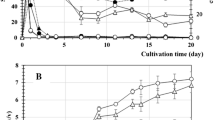Abstract
Natural vinegar is a food supplement, tonic and nutraceutical produced by twin fermentation of sugar to acetic acid via ethanol. The fermentation of sugarcane juice carried out with Saccharomyces cerevisiae MTCC 11815 produced 9.11 % (v/v) of ethanol with a fermentation efficiency of 89.8 % in 72 h. Statistical optimization of acetic acid fermentation revealed that immobilized cells of Acetobacter aceti (grown in 2 g/L DAHP supplemented jaggery solution) adsorbed on 15-mm-sized Melona grandis wood shavings for 15 h had the highest adsorption rate (66.6 %) followed by Tectona grandis (44.4 %) and Castania sativa (21.4 %) with maximum viable count of 12.76 × 107 and 6.0 × 107 cfu/g in absence or presence of substrate, respectively. A 1L plastic fermenter packed up to half of its length produced sugarcane vinegar with 5.0 % (w/v) volatile acidity in 6 days. These optimized conditions scaled to 5 L in PVC column reactors and 50 L plastic fermenter produced 7.0 % (w/v) and 4.0 % (w/v) volatile acidity in 6–7 days and 7–10 days, respectively. The sugarcane vinegar had a mean sensory score of 8.61 ± 0.52 in comparison to commercial brands with sensory scores of 7.22 ± 0.76 and 7.47 ± 1.02.
Similar content being viewed by others
References
Berraud, C. 2000. Production of highly concentrated vinegar in fed batch culture. Biotechnology Letters 22: 451–454.
Caputi, A., and D. Wright. 1969. Collaborative study of determination of ethanol in wine by chemical oxidation. Journal of Association of analytical chemistry 52: 85.
De Ory, I., L.E. Romero, and D. Cantero. 2004. Optimization of immobilization conditions for vinegar production. Siran, wood chips and polyurethane foam as carriers for Acetobacter aceti. Process Biochemistry 39(5): 547–555.
Fregapane, G., H.R. Fernández, and M.D. Salvador. 2003. Continuous production of wine vinegar in bubble column reactors of up to 60-litre capacity. European Food Research and Technology 216: 63–67.
Gaur, V.N., CEO, Food Safety and Standards Authority of India. 2011. Chapter 2.3.46 Vinegar. In The Gazette of India: extraordinary [Part III—Sec. 4], Ministry of Health and Human Welfare, 354. New Delhi: Govt. Press. www.fssai.gov.in.
Joshi, N. 2010. Standardisation of fermentation conditions for production of concentrated sugarcane vinegar. MSc Thesis, PAU, Ludhiana.
Kearns, J. 2007. Charcoal filtration basics. www.aqsolutions.org/resources/charcoal_filteration.pdf. Accessed 15 July 2015.
Kocher, G.S., and H.K. Dhillon. 2012. Fermentation production of sugarcane vinegar by immobilized cells of Acetobacter aceti under packed bed conditions. Sugar Tech 15(1): 71–76.
Kocher, G.S., K.L. Kalra, and R.P. Phutela. 2006. Comparative production of sugarcane vinegar by different immobilization techniques. Journal of Institute of Brewing 112(3): 264–266.
Kocher, G.S., R.P. Phutela, H.K. Dhillon, S.K. Uppal, J.K. Arora, and D. Bakshi. 2014. Standardization of an economical bioprocess for production of natural vinegar from sugarcane. Sugar Tech 16(1): 15–21.
Krusong, W., A. Vichitraka. 2011. An air-lift acetifier with mash recycling system for corn vinegar production by Adsorbed cells of Acetobacter aceti WK on surface of loofa sponge. In 2nd International conference on biotechnology and food science IPCBEE, vol. 7, 86–90.
Kumar, D., P.S. Chauhan, N. Puri, and N. Gupta. 2014. Production of alkaline thermostable protease by immobilized cells of alkalophilic Bacillus sp. NB34. International Journal of Current Microbiology Applied Sciences 3(10): 1063–1080.
Lea, A.G.H. 1989. Cider vinegar. In Processed apple products, ed. D.L. Downing, 279–301. New York: Van Nostrand Reinhold.
Lotong, N., W. Malapan, A. Boongorsrang, and W. Yongmanitchai. 1989. Production of vinegar by Acetobacter cells fixed on a rotating disc reactor. Applied Microbiology and Biotechnology 32: 27–31.
Miller, C.C., Y. Park, M.W. Pariza, and M.E. Cook. 1994. Feeding conjugated linoleic acid to animals partially overcomes catabolic responses due to endotoxin injection. Biochemical and Biophysical Research Communication 198: 1107–1112.
Milling, A., R. Kehr, A. Wulf, and K. Srnalla. 2005. Survival of bacteria on wood and plastic particles: Dependence on wood species and environmental conditions. Holzforschung 59: 72–81.
Naveet. 2009. Scale up of tea vinegar production using immobilized Acetobacter aceti cells. MSc Thesis, PAU, Ludhiana.
Nanba, A., K. Kimura, and S. Nagai. 1985. Vinegar production by Acetobacter rancens cells fixed on a hollow fiber module. Journal of Fermentation Technology 63: 175–179.
Park, Y.S., H. Ohtake, M. Fukaya, H. Okumura, Y. Kawamura, and K. Toda. 1989. Enhancement of acetic acid production in a high yield cell density culture of Acetobacter aceti. Journal of Fermentation and Bioengineering 68(5): 315–319.
Rivera-Espinoza, Y., E. Valdez-López, and H.S. Hernández. 2005. Characterization of a wine-like beverage obtained from sugarcane juice. World Journal of Microbiology & Biotechnology 21: 447–452.
Sossou, S.K., Y. Ameyapoh, S.D. Karou, and C.D. Souza. 2009. Study of pineapple peelings processing into vinegar by biotechnology. Pakistan Journal of Biological Sciences 11: 859–865.
Tesfaye, W., M.L. Morales, M.C. García-Parrilla, and A.M. Troncoso. 2002. Wine vinegar: Technology, authenticity and quality evaluation. Trends in Food Science & Technology 13: 12–21.
Yang, H.L., Z.L. Qi, X.L. Xia, Y. Xin, L. Zhang, Y.W. Leng, W. Quan, and W. Wang. 2011. An optimum medium designed and verified for alcohol vinegar fermentation. African Journal of Biotechnology 10(42): 8421–8427.
Yang, S.T. 2007. Bioprocessing for value added products from renewable resources. Elsevier, UK: New Technology and Applications Oxford.
Acknowledgments
The authors are thankful to UNATI cooperative society, Talwara for providing student fellowship to Mr. Sourav Kumar for carrying out this research work.
Author information
Authors and Affiliations
Corresponding author
Ethics declarations
Conflict of interest
The authors declare that there is no conflict of interest concerning this manuscript.
Rights and permissions
About this article
Cite this article
Kumar, S., Kocher, G.S. Upscaled Production of Sugarcane Vinegar by Adsorbed Cells of Acetobacter aceti Under Semi-Continuous Fermentation Conditions. Sugar Tech 19, 409–415 (2017). https://doi.org/10.1007/s12355-016-0487-1
Received:
Accepted:
Published:
Issue Date:
DOI: https://doi.org/10.1007/s12355-016-0487-1




